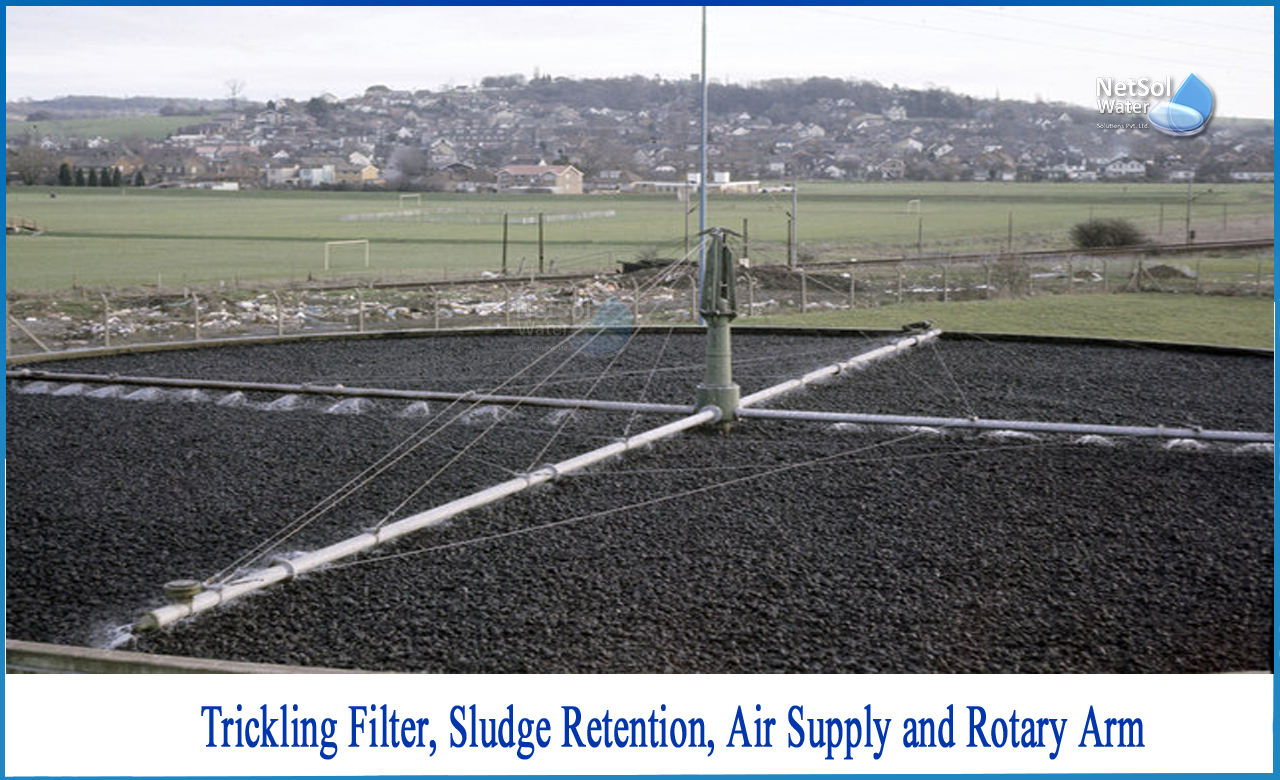Introduction to Trickling filter
Trickling filter is a type of wastewater treatment system. It is made out of a fixed bed of pebbles, coke, gravel, slag, polyurethane foam, sphagnum peat moss, ceramic, or plastic media over which sewage or other wastewater runs downwards, causing a layer of microbial slime (bio-film) to form and cover the medium. Splashing, diffusion, and either forced-air, flowing through the bed or spontaneous convection of air, if the filter material is porous, helps to maintain aerobic conditions. Treatment of sewage or other wastewater with trickling filters is one of the most well-known and well-established treatment methods.
Classification of Trickling filters
Trickling filters are determined on the basis of their hydraulic and organic loads. They can be categorized as:
1: Standard Rate Filter
Hydraulic ratings of 1.1 to 4.3 m3/m2/d and organic loadings of 0.08 to 0.41 kg BOD/m3/d are common for standard rate trickling filters. These filters are usually rectangular or round in shape and 1.8 to 2.4 meters deep.
Dosing tanks with automatic siphons or periodic pumps are commonly used to dose them on a regular basis. A thick growth forms in the filter during normal operation until a temperature change or the flow through the filter causes a large portion to slough off. This sloughing is known as "unloading," and it normally happens in the spring or fall. The sloughed material is a humus-like material that is stable and easily settled, and frequently contains a large number of worms and filter fly larvae.
2: Intermediate Rate Filter
Intermediate rate filters, including recirculation, are typically designed to treat hydraulic loadings of 4 to 10 m3/m2/d and organic loadings of 0.24 to 0.48 kg BOD/m3/d.
In the past, there have been instances where the intermediate organic loading encouraged significant biological filter development while the hydraulic loading was insufficient to prevent clogging of the trickling filter medium. Other plants in this range have experienced minimal operational issues. In certain circumstances, high rate filters are actually under-loaded intermediate rate filters.
3: High Rate Filter
High-rate filters are often built to handle far higher loadings than standard-rate filters. A filter that receives BOD loadings ranging from 0.4 to 4.8 kg BOD/m3/d. These filters are normally spherical and range in depth from 0.9 to 2.4 meters.
They are built to receive wastewater on a continuous basis. The high rate of application is achieved by recirculating wastewater that has previously passed through the filter. The continuous rather than periodic sloughing of the filter growths is caused by the strong flow of wastewater over the filter media. Because the solids are not kept as long in the high rate filter as they are in the regular rate unit, they are less stable and continue to exert BOD after leaving the filter.
4: Roughing Filter
Roughing filters are high-rate filters that are used to handle organic loads more than 1.6 kg BOD/m3/d. (It's not uncommon for roughing filters to be loaded at rates exceeding 3.2 kg BOD/m3/d.) These filters are frequently used to pre-treat trash before it is fed to an activated sludge facility. Synthetic media is used in the majority of roughing filters nowadays.
5: Super High Rate Filter
Bigger hydraulic loadings and a substantially greater filter depth are the main distinctions between super and high rate filters. Some ultra-high rate filters can withstand hydraulic loads of up to 162.3 m3/m2/d. The majority of these filters are packed towers with depths of up to 12 meters.
What is the various terms related to Trickling Filters?
1: Sludge retention
When compared to ASP, the sludge is kept in the trickling filter for a much longer time, with a typical mean cell residence time of 100 days or more. Because estimating the amount of actual biomass in the reactor is challenging, an exact measurement is not attainable. Due to the longer retention duration of biomass supporting endogenous decay, excess sludge formation in this method is projected to be lower. The amount of sludge produced by ASP when treating the same waste water is 60 to 70% lower. The amount of sludge produced by a high trickling filter is greater than that of a low trickling filter.
2: Air supply
Through natural draught, air is provided at a low and high rate trickling filter. When the waste water temperature is less than the ambient temperature, air will flow downhill; when the waste water temperature is more than the ambient temperature, air will flow upward. To allow air circulation, the under drainage system should be built to flow no more than half full.
3: Rotary arm
It revolves at a rate of between 0.5 and 2 revolutions per minute.
For a two-arm system, the peripheral speed will range from 0.5 to 4 meters per minute. Depending on the filter's diameter, the arm length could range from 3 to 35 meters. After 15cm above the filter bed, this rotational arm delivers the waste water. To avoid solids deposition, the velocity of waste water travelling through the arm should be greater than 0.3m. On this arm, a number of ports, normally of equal size, are supplied to deliver waste water in a horizontal direction. There are at least two arms available, but there might be as many as four.
What can Netsol Water offer?
Netsol Water is a pure-play technology company that offers a variety of wastewater-related solutions around the world, including resource conservation, optimization, recycling, and reuse.
Netsol Water is Greater Noida-based leading water & wastewater treatment plant manufacturer. We are industry's most demanding company based on client review and work quality. We are known as best commercial RO plant manufacturers, industrial RO plant manufacturer, sewage treatment plant manufacturer, Water Softener Plant Manufacturers and effluent treatment plant manufacturers. Apart from this 24x7 customer support is our USP. Call on +91-9650608473, or write us at enquiry@netsolwater.com for any support, inquiry or product-purchase related query.



